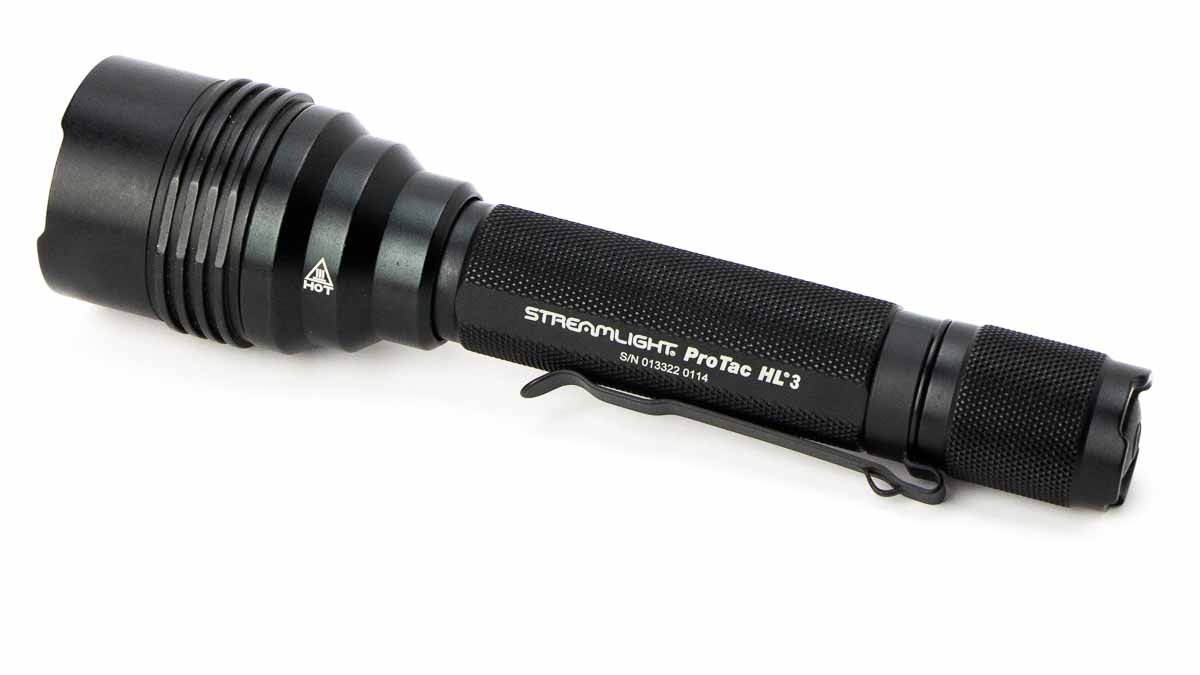The modern flashlight is almost unbelievable in its ability to project light when compared to models from just two decades ago. A popular tactical light in the ’90s put out about 80 lumens and was considered by many to be revolutionary. The new Streamlight ProTac HL 3 is not much larger than that light but produces more than 13x its total light output at 1,100 lumens.
This is a review of the ProTac HL3. It was introduced earlier this year by Streamlight at the 2014 SHOT Show. I’ve done my best to give you a good overview of the light and how I think it performs.
Feedback is always welcome. If you have used this flashlight yourself, please leave a note in the comments section with your own thoughts on it. Other readers will benefit greatly from a variety of opinions on the light.
Please note that this article is a review of the HL 3 flashlight. This article does include a comparison of the HL 3 and the original ProTac HL. However, for a complete look at the original ProTac HL, click here.
Quick Takeaways
– exceptionally bright light with a long throw
– output over time is not ideal (see runtime section below for details)
– quality build with drop and water resistance
– best price through our affiliate link
Features
The ProTac line of flashlights is handheld professional lights designed for real-world use. They feature high-quality C4 LEDs and impact-resistant bodies. The HL3 is the largest flashlight in the ProTac line, which is generally composed of compact lights. With the additional size, comes additional power.
Light Output
In general, light output for flashlights is measured in two ways: total light output and peak beam intensity. These things measure two different aspects of the projected light and there can be confusion between them. Before giving you the specs of the ProTac HL3, let me explain what the numbers measure.
Total light output is generally expressed as the whole amount of light being emitted by the source. It is not necessarily focused. This measurement is typically expressed in lumens.
Peak beam intensity, on the other hand, measures the center bright spot of a focused beam. This is often expressed in candelas. It can also be expressed as a distance or length of useable beam expressed in meters.
A standard light bulb may have a high number of lumens, but a low number of candelas because it puts out a lot of unfocused light. A small flashlight could put out fewer lumens but project useable light farther than the light bulb because of its focus. The flashlight would have a higher candela measurement than the bare light bulb even though the total output (lumens) was smaller.
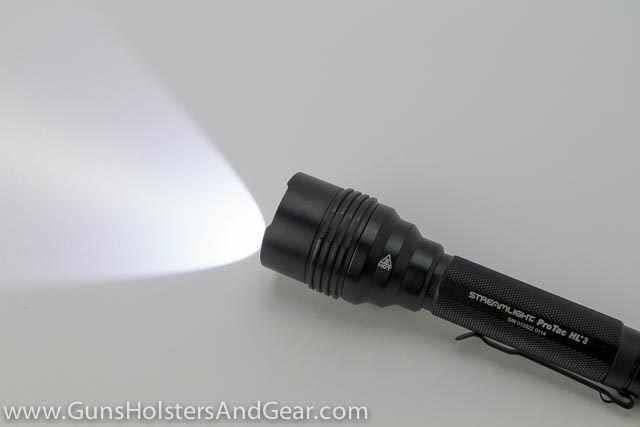
These measurements are self-governed by the flashlight companies that adhere to a set of voluntary standards (ANSI/NEMA FL-1-2009.) There has been some concern about the ability to manipulate the numbers to the manufacturer’s benefit. However, prior to the development of the standards, there was no real way for consumers to make a comparison between brands and models. Without cheap ways for consumers to test lights, we are largely dependent on our own observations of how the lights perform.
It should be noted that many, but not all, of the major flashlight manufacturers adhere to these standards. Streamlight is one of the companies that adhere to the standards.
The HL3 is rated for 1,100 lumens of total light output and 36,000 candelas of peak beam intensity. In relation to many of the other flashlights I have used, this torch puts out a lot more total light and is one of the brightest I have used. The beam distance measures 379 meters (more than 1,200 feet.)
There is a very distinct bright spot in the center of the beam, which I would expect from a flashlight with this many candelas. However, there is a nice spill of useable light that gives you a very good illumination of close-in, periphery areas.
A low power mode is available through the manipulation of the light switch. In this setting, lumens are reduced to 35 and candelas to 1,200. This is more than enough light for navigation or an examination of something.
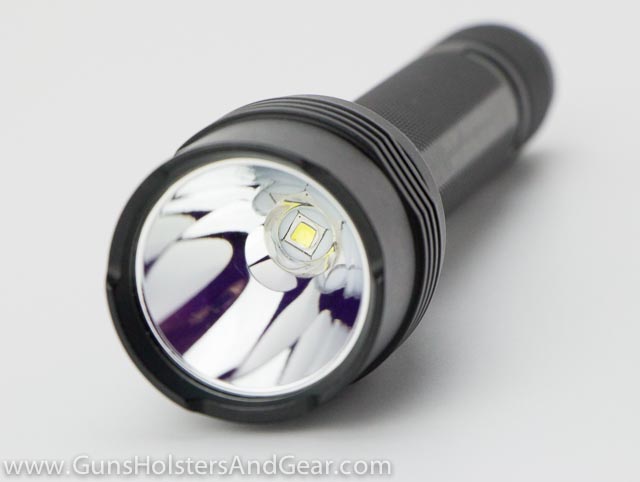
For the properly trained, there is a strobe mode. I was somewhat skeptical of strobing flashlights until I started using one when I was still a police officer. The first time I used it in the field, it helped me and my partner take a wanted felon into custody without needing to use force.
As the subject had a long history of violence, was wanted for a violent crime and knew we were looking for him, I figured it would not be a quiet arrest. Yet, hitting him (figuratively) with the strobe in the face completely disoriented him, unlike any constant beam flashlight I had seen. After being handcuffed, the subject stated he didn’t know what was happening (when the light hit him) and he thought he was seeing aliens. He was using hyperbole, but the point was pretty clear to me.
Switches
The HL 3 uses a tail cap, push-button switch. Lightly pressing it will get a momentary ON response. Fully depressing the switch will click it for a constant ON function.
As with the prior Pro Tac HL flashlight, the HL 3 uses a programmable switch called TEN-TAP. This allows the user to choose one of three programs for the button activation. By rapidly half-pressing the switch, the user can move between light modes.
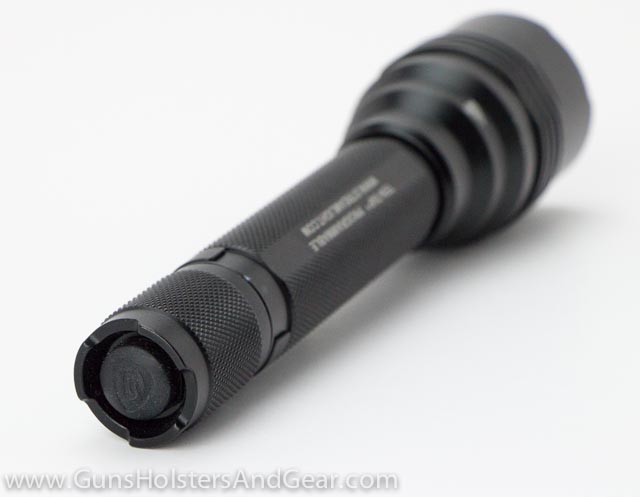
As the flashlight ships, the first depress will activate the light in the high mode (full brightness.) A quick double-tap will activate the strobe mode as long as the switch is depressed. Once released, it reverts back to the high mode.
A triple tap activates the low mode. As long as you keep the button pressed, the light will stay in the low mode. Likewise, if you fully depress the switch (click it on) while in the low mode, the flashlight will be in the constant ON mode at the low light level. When the light is turned off, it reverts back to the high mode for the next activation.
The other two switch programs are high mode only (no ability to purposefully or accidentally activate the strobe or low modes), and a high-low mode only (no strobe.) For someone using this as a work tool, you might want to go to the third mode (no strobe.) If you are using this as a tactical light but don’t need the strobe, the high-only mode may be best for you.
It took me a few tries to learn the TEN-TAP switch on the original ProTac. Once I did, I left it in the default position and had no problems accessing exactly what I needed. The new flashlight works exactly the same, so I had no new learning to do.
Power
Three CR123A batteries power the HL 3 flashlight. Duracell Ultra 3v lithium batteries were included in the package. This is a nice inclusion since I normally pay about $2/battery for the Duracell Ultras.
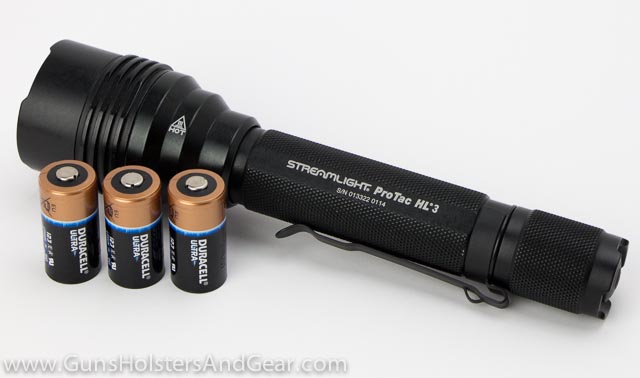
Streamlight states the flashlight will run for 90 minutes on high. On low, run time is much longer: 36 hours. Using just the strobe mode, the run time is 90 minutes.
Waterproof
According to Streamlight, the HL3 flashlight is waterproof to 30 minutes at a 1-meter depth. No one would ever claim that this is an acceptable light for diving, but if you were to drop it into a puddle or get caught in a rainstorm, it should have no problems whatsoever.
Warranty
Streamlight offers a limited lifetime warranty. If I understand the wording of the warranty, they only cover the switch for two years. Abuse of the light is not covered. I’ve used Streamlight flashlights for nearly 20 years.
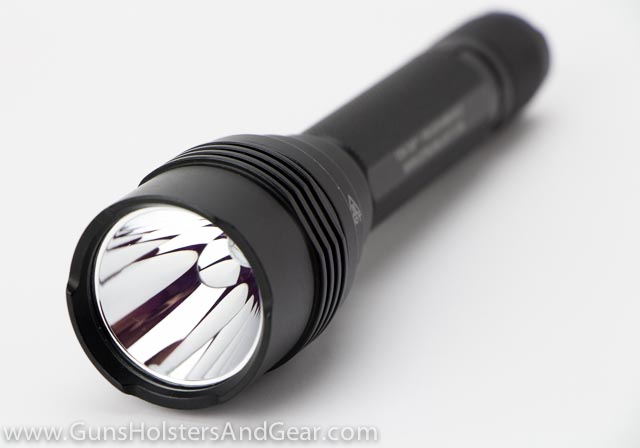
During much of that time, I carried at least one Streamlight on duty as a uniformed police officer. The lights were exposed to hot and cold temperatures, rain, snow, high humidity, salt spray and more. The lights performed very well, and I never had to call the company about a broken light.
ProTac HL3 Specifications
Here are the manufacturer’s specs of the Streamlight ProTac HL3:
| Total Light Output | 1,100 lumens |
| Peak Beam Intensity | 36,000 candelas |
| Beam Distance | 379 meters |
| Runtime (to 10% output) | 90 minutes |
| Water Resistance | waterproof to 1 meter for 30 minutes |
| Length | 7.1″ |
| Weight (w/ batteries) | 9.3 oz |
| Weight (as measured) | 9.1 oz |
| Battery Power | 3x CR123A |
| Body Material | machined aluminum |
| Lens | glass with anti-reflective coating |
| Warranty | limited lifetime |
| Includes | 3 Duracell CR123A batteries, pocket clip, nylon belt case |
In the Field Testing
Let me be perfectly clear: I do not have any of the equipment needed for the scientific testing of a flashlight. I’d love to buy some, but that gear is simply not in the budget. So, I have to give you information based on my own observations and informal testing. That means the tests are imperfect and should not be considered authoritative.
How Much Light
From a purely subjective standpoint, the HL3 is one of the brightest lights of this size I have had a chance to handle. The center spot is very bright and projects very far.
The periphery cone is also fairly bright and well-defined. All of this is a testament to how well the reflector works to focus the light. The LED is bright, no doubt, but the reflector is what focuses that light and makes it useable as a flashlight.
For working on pretty much anything, I would use the low output mode. For searching around outside at night, the high output mode worked very well.
Running some basic room clearing practice, the light worked as expected, though I did find myself wanting to step down to my 600 lumens/16,000-candelas ProTac HL. More on that below.
Run Test
This one is difficult to objectively measure without the right tools. With my integrating sphere, I hope to offer some…illumination…into the real-world runtime of this flashlight.
The stated run time is 90 minutes. The way the standards are set, that does not mean you will necessarily get the full 1,100 lumens for a full 90 minutes. In fact, on a fresh set of batteries, most lights will give a few minutes of output near the stated maximum and then taper off. When the light output falls to a mere 10% of the original output, the timer stops and that is the stated run time.
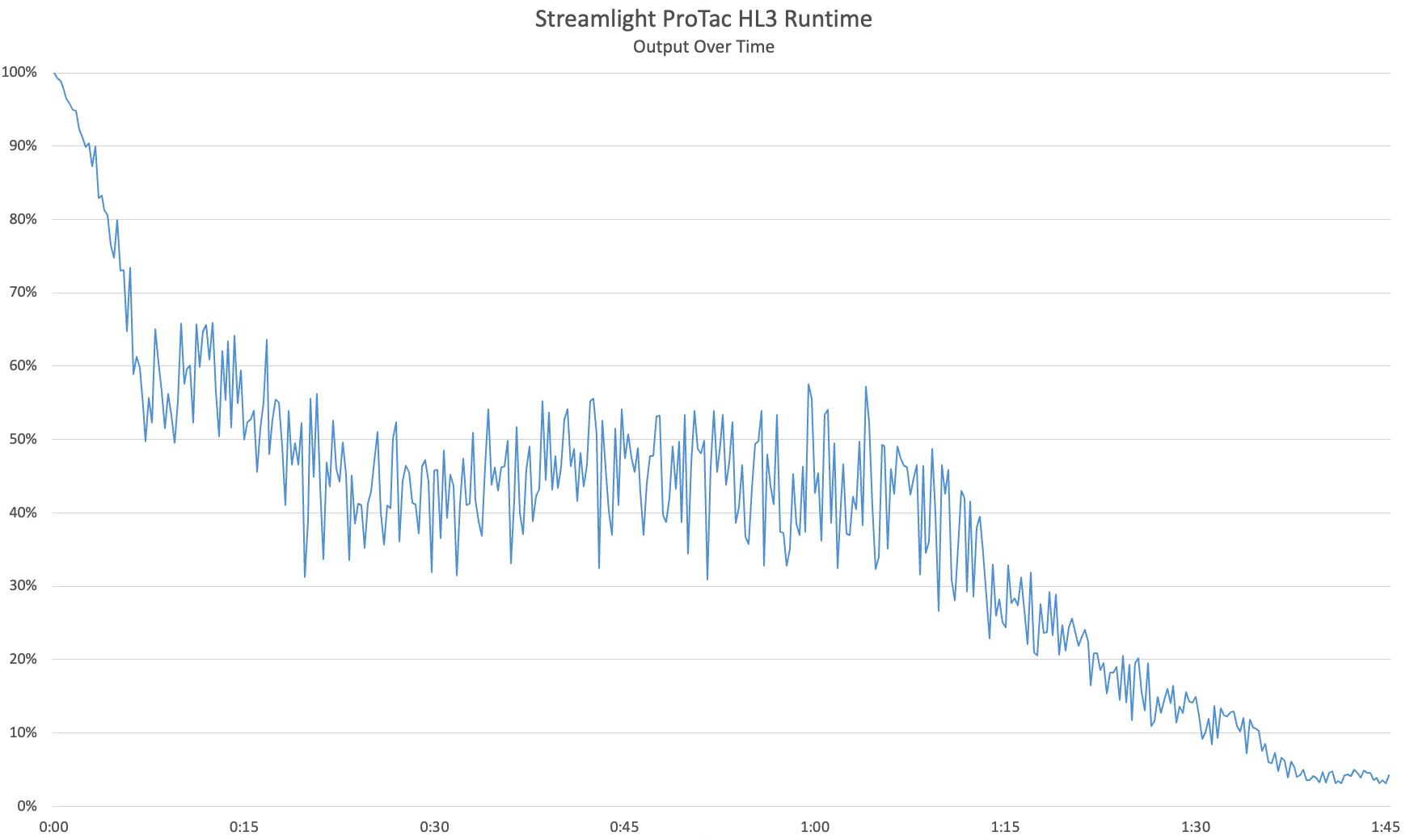
On the high output, the total output drops substantially by just 10 minutes into the run. Around the 20 minute mark, output varies between 30-60%. After an hour, the output begins to taper off, crossing the 10% threshold around 1.5 hours.
The upside is that Streamlight accurately reported the runtime as per the industry standard. However, the rapid decline in power after just a few minutes was disappointing.
Visually, I could notice dimming by 10 minutes. In my mind, that’s not ideal for a tactical light. Nevertheless, Streamlight’s reported data appears accurate.
Drop Test
According to Streamlight, the flashlight is impact resistant to 1 meter. I took my light out onto the concrete sidewalk with a tape measure. From a distance of slightly more than one meter, I dropped the flashlight three times: once head first, once tail first, once from the side. After the third drop, I realized my tape measure failed to lock in place, and the drop distances were short of one full meter.
I ran the drop test a second time and made sure the distances were all above 40″ (1.016m.) After six drops, there were some small blemishes to the finish of the flashlight. However, there was no damage that appeared to be more than cosmetic. The light worked fine and there was no damage to the lens or switch.
Water Test
I did the water test after the drop test because I wanted to really test the integrity of the flashlight’s seals. For example, if you are working around a pool and drop the light, it is most likely going to hit a hard surface before rolling into the water.
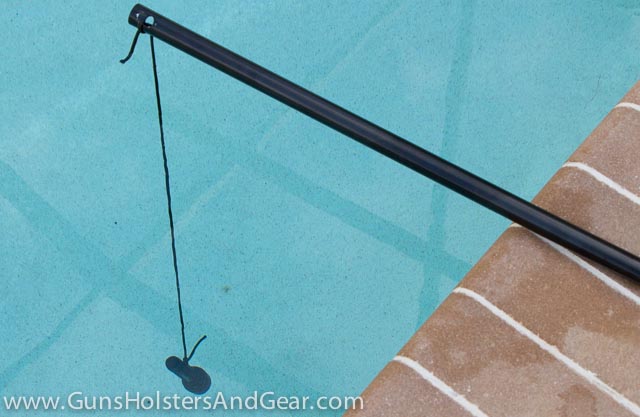
For the water test, I utilized my saltwater pool and a 1-meter length of paracord. Actually, it was an inch or two over the one-meter length. Making sure the light would hang at slightly more than one meter below the surface, I dropped it in and set the timer on my phone. At the 45 minute mark, I pulled the light back up and clicked the switch. I got instant light.
There was some water intrusion into the lens area of the light. There was no intrusion into the body or electronics area of the light. My understanding of the standards is that water intrusion that does not prevent the light from working is still measured as a pass. Therefore, the light meets this standard.
Of course, I also ran the test beyond the limits that Streamlight states the flashlight will operate. The test time was 50% longer and at a very slightly increased depth. In fairness, I’d say that the flashlight did well considering the prior drop tests and increased level of difficulty. A rain storm or drop into a mud puddle will not harm this light.
Pricing
Streamlight lists the MSRP of this flashlight at $155. However, one thing I have always noticed about Streamlight is the MSRP seems to always be about double the price I can find it for online. In fact, at the time of this writing, Amazon is selling the flashlight for about $80 including free two day shipping.
ProTac HL vs. HL3
I own and have regularly carried the ProTac HL flashlight for two years. I thoroughly like the original HL, and have bought several for family members. How does it compare to the new HL3?
Size & Weight
The HL 3 is definitely longer and heavier than the original. Whether that makes any difference to you depends on your own needs.
Since the HL3 uses three batteries, its body is necessarily longer than the older HL model that only uses two. The original is 5.4″ long while the new model is 7.1″ long. I’ve found that the original HL fits easily into the cargo pocket of a pair of shorts or pants, but the HL3 is just a little too long to do so comfortably. Also, I can carry the HL in a regular jean pocket using the flashlight clip, but this isn’t possible with the HL3.
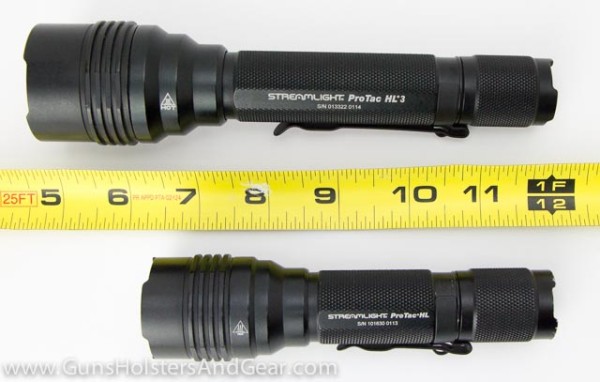
The head of the HL3 is also significantly larger in diameter than the original. It is not weirdly out of proportion to the rest of the light, but it is something to be aware of.
I measured the weight of both lights on my digital postal scale. The new flashlight weighs in at 9.1 oz, while the older model weighs only 5.6 oz. I should note that Streamlight states the weight of the HL3 is 9.3 oz. Depending on your intended use, that difference may not be very important to you. If the light is to spend most of its time on a nightstand or in a tool box, the weight isn’t going to be a concern at all.
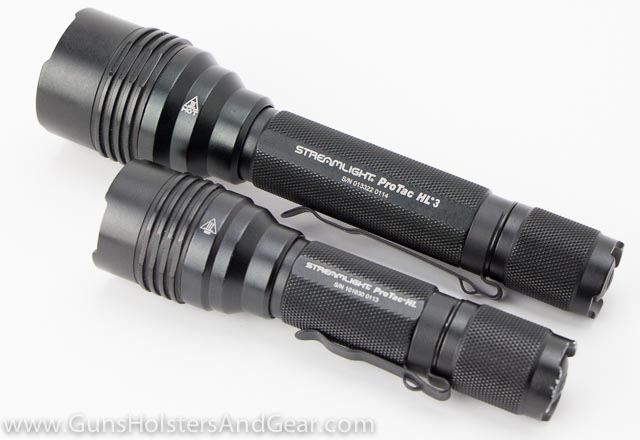
If you plan on carrying it regularly – perhaps as a police officer or security guard – having the extra weight on your belt may be more than you want. Let’s face it, in modern times, law enforcement officers are expected to carry everything under the sun on their person – from video cameras to multiple force options to anti-opiate drugs. Things are reaching the absurd and being able to lighten the load by a few ounces here and there can make a big difference.
Useable Light
There is no doubt – the HL3 is much brighter than the original. However, in some circumstances, the extra light might not be much more useful than the original. The first ProTac HL throws 600 lumens and 16,000 candelas. The new HL 3 roughly doubles that output. The reach of the light is definitely improved, and if you are considering the lights for any outdoor purpose, the HL3 has a clear edge here.
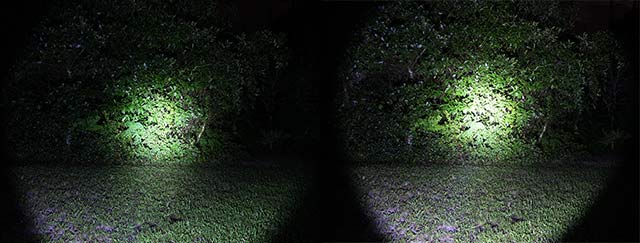
From search & rescue to checking the back 40, the HL3 is simply going to throw more concentrated light a longer distance. According to Streamlight’s lab testing, you will get more than 120 meters of additional beam distance from the larger light.
For closer in work, such as room clearing inside a typical home, the light is overwhelming. I have found the 600 lumens on the original flashlight to be just about perfect for room clearing. The larger light brings a lot more light to the game, which can have an overpowering effect on any bad guys that might catch the beam in the eyes. The problem is when using the light in dark conditions, the light can also be somewhat dazzling to the user.
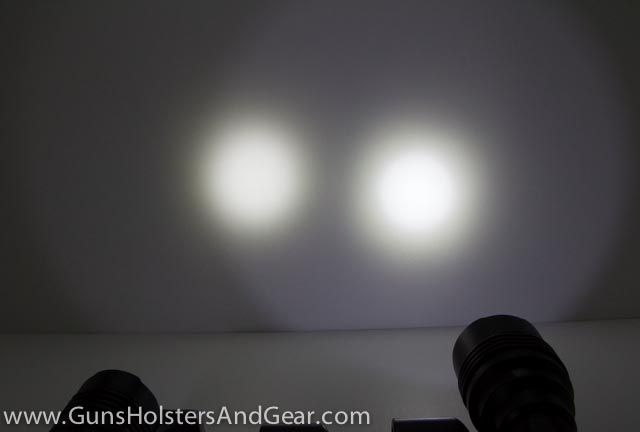
Don’t get me wrong, the user is in a much better position than the bad guy who catches the light directly. However, the HL3 user can also suffer some minor distractions from the extreme power of the light. I did not notice this problem in low light conditions or outside – just in very dark conditions where the walls and other reflective surfaces were 10′ (or less) away.
Heat
Both flashlights get warm when used for more than a minute or two on the high output level. Such is the nature of high-intensity light production. The HL3 does get hotter than the original light. At no point did it get so hot as to burn my hand, but it did become very uncomfortable after about five minutes of constant running. At some point, it does become unusable without a glove. On a cold winter night, this would be a great hand warmer. If you are using the light intermittently – such as during a building search – the flashlight does not get hot at all. The low output level does not generate the same amount of heat.
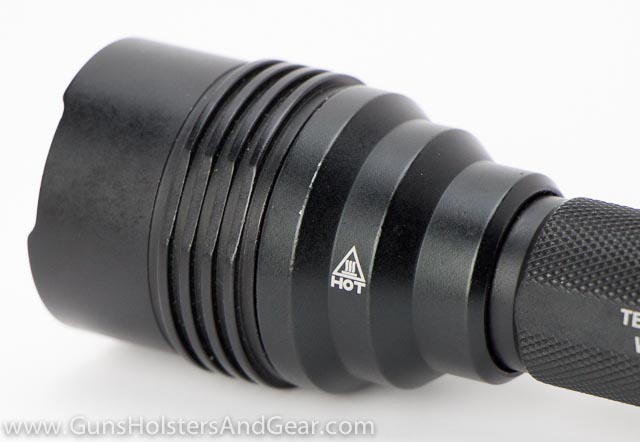
The Bottom Line
The ProTac HL3 is an excellent light that I think will serve anyone well for a long time. However, I also feel it is a bit of a specialized tool that will make some people much happier than others.
For anyone working outdoors, I think the flashlight is a great choice. It offers a lot of reach and is rugged enough to ride on your belt or in the truck without worries. The lithium batteries mean it will store for a long time, yet still have plenty of juice when you need it. Also, the waterproof nature of the light will keep it from dying should it get rained on.
For anyone needing a light for concealed carry, I don’t think the size of the light will work well for you. Take a look at the original ProTac HL for a better choice.
If you are looking for a light for home defense, it is a good choice, though you might want to also consider the original HL. Should you land on the side of the HL3, make sure you do work with the light in dark conditions so you have a good idea of how the splashback of light might affect you.
These lights carry a suggested retail price of $155 and come with three Duracell batteries. However, you can almost always get them much cheaper than that.
Last Update: August 16, 2021
Disclosure
GunsHolstersAndGear.com is an independent, for-profit website. I do not charge readers a dime to access the information I provide.
Some of the links on this page and site are affiliate links to companies like Amazon and Palmetto State Armory. These links take you to the products mentioned in the article. Should you decide to purchase something from one of those companies, I make a small commission.
The links do not change your purchase price. I do not get to see what any individual purchases.
